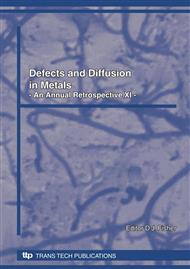[1]
C. Baik et al., Organic dyes with a novel anchoring group for dye-sensitized solar cell applications: Journal of Photochemistry and Photobiology A, 2009, 201, 168.
DOI: 10.1016/j.jphotochem.2008.10.018
Google Scholar
[2]
Y. Bessekhouad et al.,. Synthesis of photocatalytic TiO2 nanoparticles: optimization of the preparation conditions: Journal of Photochemistry and Photobiology A, 2003, 157, 47.
DOI: 10.1016/s1010-6030(03)00077-7
Google Scholar
[3]
M. Gratzel et al.,. Conversion of sunlight to electric power by nanocrystalline dye-sensitized solar cells: Journal of Photochemistry and Photobiology A, 2004, 164, 3.
DOI: 10.1016/j.jphotochem.2004.02.023
Google Scholar
[4]
M. Gratzel et al.,. Dye-sensitized solar cell: Journal of Photochemistry and Photobiology C, 2003, 4, 145.
Google Scholar
[5]
Jinting Jiu et al.,. Performance of dye-sensitized solar cell based on nanocrystals TiO2 film prepared with mixed template method: Solar Energy Materials and Solar Cells, 2005, 87, 77.
DOI: 10.1016/j.solmat.2004.06.011
Google Scholar
[6]
Jinting Jiu et al., Preparation of highly photocatalytic active nano-scale TiO2 by mixed template method: Materials Letters, 2004, 58, 3915.
DOI: 10.1016/j.matlet.2004.08.017
Google Scholar
[7]
I. Kartini et al., A novel route to the synthesis of mesoporous titania with full anatase nanocrystalline domains: Journal of Sol-Gel and Tech., 2004, 31, 185.
DOI: 10.1023/b:jsst.0000047984.60654.a1
Google Scholar
[8]
Kavan et al.,. Mesoporous thin film TiO2 electrodes: Microp. and Mesoporous Material, 2001, 44-45, 653.
DOI: 10.1016/s1387-1811(01)00246-3
Google Scholar
[9]
D.U. Lee et al.,. CTAB facilitated spherical rutile TiO2 particles and their advantage in a dyesensitized solar cell: Solar Energy, 2008, 82.
DOI: 10.1016/j.solener.2008.04.006
Google Scholar
[10]
S. Lee et al.,. Modification of electrodes in nanocrystalline dye-sensitized TiO2 solar cells: Solar Energy Materials and Solar Cells, 2001, 65, 193.
DOI: 10.1016/s0927-0248(00)00095-7
Google Scholar
[11]
Seigo Ito et al., Fabrication of thin film dye sensitized solar cells with solar to electric power conversion efficiency over 10%: Thin Solid Films, 2008, 516, 4613.
DOI: 10.1016/j.tsf.2007.05.090
Google Scholar
[12]
K. Wessels et al., Low-Temperature Preparation of Crystalline Nanoporous TiO2 Films by Surfactant-Assisted Anodic Electrodeposition: Electrochemical and Solid-State Letters, 2006, 9.
DOI: 10.1149/1.2186430
Google Scholar
[13]
P.T. Yvonne, Functionalized and Structuring Titania, PhD dissertation, Massey University, New Zealand, (2008).
Google Scholar


